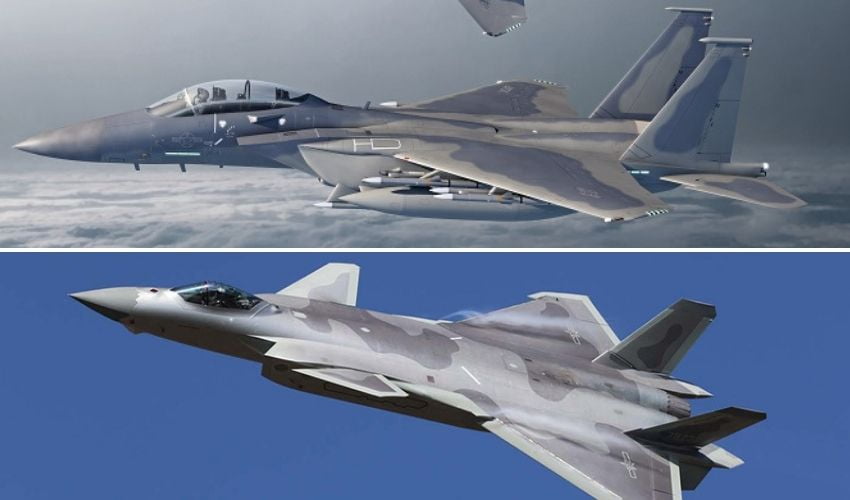The Russian invasion of Ukraine has sparked fears that China would follow suit against Taiwan. Japan is particularly anxious about a possible Chinese strike because of its proximity to the besieged island state.
Japan’s sanctions against Russia and harsh language against Moscow are geared at sending a message to Beijing that will dissuade it from carrying out similar measures against Taiwan. The Japanese are concerned because they believe that any conflict between China and Taiwan will surely bring Tokyo into its fold.
Furthermore, tensions between Japan and China have been high for over a year.
Between April and December last year, the Japan Air Self-Defense Force intercepted a record number of foreign aircraft approaching the country’s airspace, the majority of which were Chinese fighters tracked down by its F-15J Eagles.
Shortly after the PLA Air Force began routine intrusions into Taiwan’s Air Defense Identification Zone, Chinese hostility against Japan began to grow (ADIZ). Chinese activities near the south-western region of Japan, which is close to Taiwan, and the Okinawa region, which is home to the majority of American military sites, is of special concern to Tokyo.
With Japan lately committing closer military relations with the United States and increasing defence spending to more than $8 billion, Chinese aggression and power projection against Japan is likely to rise in the near future.
According to state media, the J-20 ‘Mighty Dragon,’ China’s most advanced stealth aircraft, was deployed to air force units patrolling the Taiwan Strait and the East China Sea last year. Chinese observers viewed the move as a message to US allies Japan and South Korea in the region.
The J-20s were also deployed to a facility in China’s Eastern Command, which is responsible for the Taiwan Strait and the East China Sea. As a result, the J-20s pose a serious danger to the JASDF.
The F-15 Eagles are primarily used by the JASDF to intercept Chinese jets in the East China Sea. In response to a growing security threat from PLA in the region, Japan is updating its existing fleet of F-15s.
To monitor the vast oceans surrounding the Japanese archipelago, the powerful twin-engine fighters combine swift speed, modern radars, and massive fuel and armament loads. The improvements would bring 68 Eagles up to F-15 JSI (Japanese Super Interceptor) level. A new electronic warfare system, avionics, and missiles would be included in the next model.
The US Air Force awarded Boeing a deal for more than $470 million in December last year to construct new equipment for Japan’s F-15 Eagle Super Interceptors. However, whether these F-15s can endure Chinese J-20s remains to be seen.
Mighty Dragons vs. Super Interceptor Eagles
The F-15J is a multi-role supersonic fighter with all-weather air dominance. This aircraft, which is based on the US Air Force’s F-15C Eagle, is operated by the JASDF.
The F-15 is one of America’s most effective and combat-proven modern fighter jets, with over 100 confirmed kills and zero losses in aerial combat. The F-15 has long been regarded as the most capable dogfighter in the US Air Force, and it has now been updated to the sophisticated F-15EX type to replace the F-15C. It is used as an interceptor in Japan.
The J-20, on the other hand, is a single-seat stealth aircraft with forward canards and twin engines. Internal weaponry and fuel storage are stored in a long, broad fuselage, which is slightly longer than the F-15J.
Internally, it looks to feature three armament bays: two for short-range missiles and one for long-range air-to-air missiles and air-to-ground armaments. Japan announced this month that it would upgrade 68 Mitsubishi F-15J Eagle interceptors with radar, electronic warfare, weapons carriage capacity, and stand-off weapon capabilities.
The Lockheed Martin AGM-158 Joint Air-to-Surface Standoff Missile, or JASSM, would be installed on the modified F-15s. The certification includes the Raytheon AN/APG-82(V)1 active electronically scanned array radar, BAE Systems’ ALQ-239 Digital Electronic Warfare System (DEWS), updated mission computers, and radios.
The F-15 Super Interceptors’ ability to intercept Chinese J-20s, on the other hand, remains a mystery.
Due to its stealthy characteristics, the F-15 may have difficulty identifying the J-20 at long ranges. The F-15’s lack of stealth, on the other hand, means that a decent radar can rapidly locate the Japanese fighter. In a confrontation beyond visual range, this is bad news for the F-15J, especially if the J-20 is equipped with PL-15 missiles.
Closer ranges, on the other hand, the F-15J may have the upper hand. For the time being, the J-20 is considered to be underpowered. It was supposed to be powered by WS-15 engines, but these failed vital testing, forcing the Chinese to settle with WS-10 engines.
Both planes, however, are the greatest in their respective leagues. One is a stealthy combat aircraft with long-range firing capability, while the other is an interceptor and dogfighter. In the end, Japan intends to deploy the improved F-15JSI alongside the F-35 stealth for defence, as the latter might pose a serious threat to China’s Mighty Dragon.
